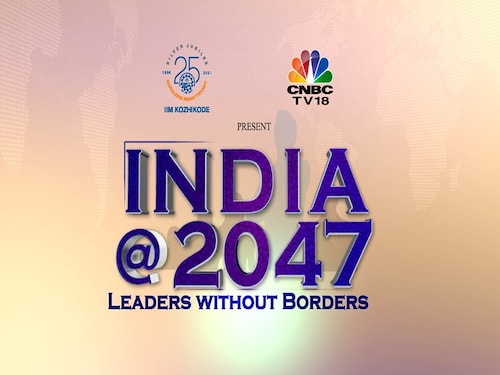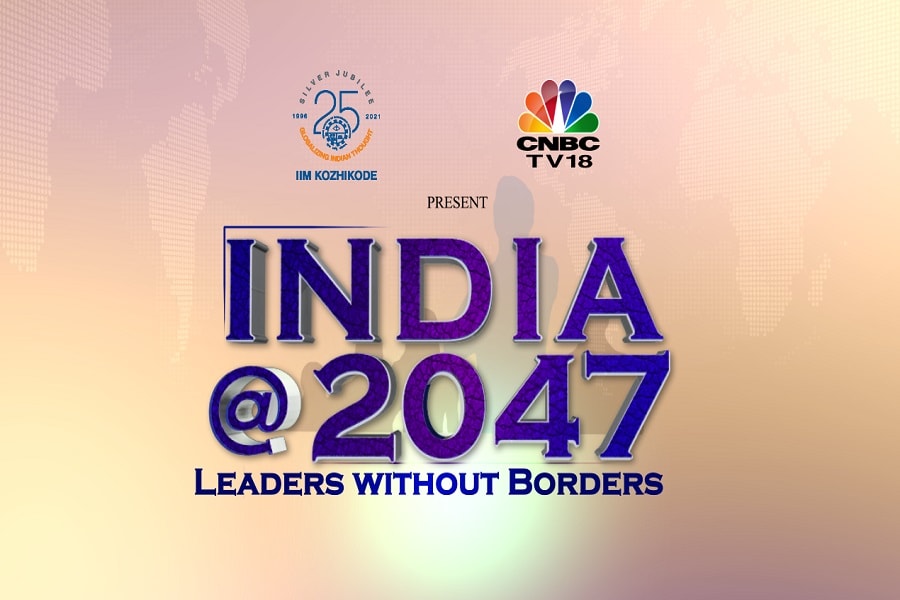CNBCTV-18 and IIM-K's India@2047 Leadership Series: Challenges and opportunities
The India@2047 Leadership series explores how fintech and digitizing healthcare could be the stepping stones to create a developed nation


 When it comes to financial transactions in India, there is clearly a pre-Covid ecosystem, and the one that came after. Almost overnight, we were all converted to active users, irrespective of whether we were skeptics, agnostics or enthusiastic evangelists of the safety and convenience of online payments.
When it comes to financial transactions in India, there is clearly a pre-Covid ecosystem, and the one that came after. Almost overnight, we were all converted to active users, irrespective of whether we were skeptics, agnostics or enthusiastic evangelists of the safety and convenience of online payments.
While many other economies pivoted similarly, India has emerged a clear forerunner when it comes to digital payments. From QR codes at every shopfront, to a record 7 billion transactions just last month on the UPI platform, to exporting our homegrown Unified Payments Infrastructure to Singapore, Europe and beyond. India is evidently on the path to becoming the global hub of innovation in financial services.
This innovation brings with it certain costs - according to a recent report by the Boston Consulting Group, Indian banks and financial institutions will be required to spend $5 billion each year to meet the demands of a digital economy that is seeing ever greater adoption from a population of 1.5 billion people. This expenditure is more than offset by the benefits a digital economy brings: from plugging credit gaps to underserved segments, to increasing income for the poorest sections, to increased penetration of insurance, to financialisation of household savings.
The question remains: will fintech achieve its potential?
As India hurtles towards the centenary year for independence it is time to both reflect on the milestones of the past and chart out a road map for an aspirational future. While the GoI readies its plans, CNBCTV-18, in association with Indian Institute of Management, Kozhikode (IIM-K) has launched India@2047, Leaders Without Borders: a 5 part leadership series that engages in a meaningful dialogue on the key drivers for our social and economic growth. In this series, CNBC-TV18"s Managing Editor Shireen Bhan and Director, IIM-K Debashis Chatterjee speak with luminaries from various fields to capture India"s aspirations, and to draw up a charter of change that will help shape the idea of India@ 2047.
The Promise of Fintech
There is some debate on the size of the fintech opportunity, particularly when it comes to the financialization of household income. According to Nitin Kamath of Zerodha, who bases his calculations on the number of people filing their tax returns, he believes the opportunity to drive investments in Capital Markets tops out at 15 crore investors. He believes that the challenge lies in creating a consistently positive experience for retail investors - each boom cycle brings in investors in droves, but most are driven away by poor performance and bad experiences. According to Nitin, the financial advisory space is the key to unlocking investor confidence, and thus, greater volume of investors.
Saurabh Mukherjee of Marcellus takes a different tack. He estimates Indian household wealth to be somewhere in the vicinity of $10 trillion, and that most of it is being invested in physical asset classes like real estate and gold. These asset classes, unfortunately, consistently underperform when compared to other financial asset classes. However, we are beginning to see the movement from physical assets to financial assets at the rate of around $100-150 billion per year. Saurabh believes that as financial products become more accessible through lower costs and greater transparency, this will unlock the full potential of India"s household wealth, and in doing so, power the credit ecosystem to deliver greater penetration to underserved segments like the MSME.
According to Professor Debashis Chatterjee of IIM-K, an environment of trust and reliability has always been the key to unlocking adoption, and the first step towards creating this environment is imparting financial literacy. "Digital literacy awareness is important to prosper in a digital economy and to safeguard against cybercrime and digital thefts. The question is one of mindsets or illiteracy, and also one of risk of appetite. When you are not sure about a medium or method of investment you tend to fall back on asset classes you understand, like gold." Professor Chatterjee also draws attention to the progress enabled by technology - bank account access has grown from a mere 10% of the population in 2008 to more than 80% today. "Technology has achieved in a decade, what otherwise might have taken half a century."
Technology as an enabler in healthcare
While Fintech adoption has its hills to climb, India"s Healthcare industry has seen a transformation that was unimaginable just three years ago. India is already known as the world"s pharmacy, exporting more than 20 billion dollars worth of affordable medicines annually, and fulfilling nearly 60% of the global demand for vaccines. In India, the pandemic fueled an urgency to reinvent outdated healthcare delivery models and has laid the groundwork for digital transformation.
The national digital health stack data is encouraging, with 400 million smartphone friendly Indians having used a digital health service at least once. That"s the demand side. On the supply side, more than 7000 Healthtech startups are driving down costs for India"s broken healthcare system. This is a promising start. India"s healthcare tourism industry ranks 10th on the Medical Tourism Index (MTI) for 2020-21 due to a combination of high quality and low costs. For the bulk of India"s population, however, quality healthcare remains just slightly out of reach.
India"s healthcare needs are intrinsically challenging. Despite the country being largely rural, the proportion of primary health centers with doctors has only gone up marginally from 17.5% in 2005 to 21.8% in 2021. Even though private healthcare providers aim to plug the gap, each year over 100 million Indians slip into poverty due to out-of-pocket health expenditure.
Biocon founder Kiran Mazumdar Shaw is very excited by the Ayushman Bharat mission, and believes that digital technologies have the opportunity to leapfrog the struggling Indian healthcare system by driving greater efficiencies and resource optimisation. Sunita Reddy of Apollo Hospitals concurs - Apollo hospitals used digital training during the worst of the Covid pandemic to upskill their nurses to manage ICUs and ventilators. Thus, greatly expanding their capacity to treat and manage Covid patients.
She believes that a combination of technology and finding the right model of private and government healthcare centers is the key to building out the primary healthcare system in a way that is affordable, efficient and accessible to a larger percentage of India"s population. Kiran also recognises that the poor outcomes we see are often due to a delay in diagnosis and its knock on effects on treatment costs, which can then make following the treatment plan unsustainable for poorer families.
This is where she sees an opportunity for Telehealth services, particularly in far flung rural areas where full-fledged primary healthcare centers can"t be made viable. The question of scale, however, still remains unanswered. Sunita, too, believes that investments in preventative healthcare can really pay off - for every one rupee invested in preventative medicine, we save six rupees.
Professor Chatterjee summed up this discussion eloquently, "We have to recognize that while death is not negotiable, healthy aging and the journey to the inevitable mortality that we all face should be a privilege and not just a pain for our people. That is the meaning of the word "Ayushman": blessed and not cursed with a long life."
He also outlined IIM-Ks 3Ds framework for transformative action in healthcare: Digitalisation that drives improvement in healthcare in both scope and scale, enabling patients to thrive instead of just surviving. Diversification has to be the core of a differential health care system: misalignment among stakeholders such as citizens, regulators, pharmaceutical device manufacturers, insurers, academics, policy makers, investors, all significantly contribute to the underperformance of the health sector. By increasing portability of data and services across open health exchanges, we get to ensure that citizens have access to such services, retain control, and have fiction free experiences.
The final D is disruption. Covid-19 broke down barriers real and imagined. "Vaccines developed at a record speed, telemedicine adoption became real, doctors started monitoring patients in home care, unprecedented community participation happened… and you could see phone-based symptomatic screening and data-driven pandemic response at various levels. The pandemic has been the disruptive trigger for rethinking the health system in India from the ground up. Both the government and private players made several changes in the overall healthcare sector to ensure the readiness and resilience of Indian healthcare. We have to think big. Incremental steps alone will not make universal healthcare a reality for 1.5 billion people."
Fortunately for India, thinking big is what India"s vision for 2047 is all about.
The pages slugged ‘Brand Connect’ are equivalent to advertisements and are not written and produced by Forbes India journalists.
First Published: Nov 29, 2022, 16:38
Subscribe Now